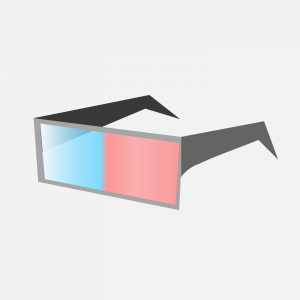Color, Depth, and Size
113 Stereo Displays
Learning Objectives
Understand how 3D stereo stimuli are created.
Be able to explain why some people cannot see 3D displays.
Stereo displays are 3D displays that are able to transmit depth perception to a person’s vision. 3D stereo stimuli use separate images presented to a person’s left and right eye in order to recreate a normal visual disparity when viewing an image with both eyes. Most stereo display systems do require the observer to wear glasses. One example is polarized glasses which are used in theaters such as IMAX 3D. These glasses have filters that isolate the left and right eyes much like the red/blue filters but retain all the color integrity of the images. Another example is anaglyph glasses which use color filters to isolate the left and right eye images.
About 5% of people cannot see 3D effects at all because they do not have stereo vision. If someone is unable to see the 3D effect at all, they may be stereo-blind. They are someone who is flat-viewer or lacks depth perception. The most common reasons for stereo-blindness are medical disorders that prevent the eyes from focusing and/or aligning correctly or loss of vision in one eye.

Learn more about stereoblindness by watching the video linked here and included below.
https://www.youtube.com/watch?v=x237dl4pnYc
Cheryl Olman PSY 3031 Detailed Outline
Provided by: University of Minnesota
Download for free at http://vision.psych.umn.edu/users/caolman/courses/PSY3031/
License of original source: CC Attribution 4.0
Adapted by: Francel Colon-Acosta
References:
Owen, D. (2010, September 1). Stereo-Blind: People who can’t see 3D. Retrieved from
https://www.mediacollege.com/3d/depth-perception/stereoblind.html
Stereo basics. (2001).WorldViz. Retrieved from
https://docs.worldviz.com/vizard/latest/index.htm#Frequently_asked_questions.htm%3FTocPath%3DReference%7C_____29

